If you’re looking for a flaky, tender gluten-free pie dough (or pastry dough) that is fabulously easy to roll out, look no further. Not only is this the best tasting gluten-free pie crust, this detailed guide is also full of tips and tricks to help you make perfect GF crust at home. The secret? A tablespoon of sour cream! It tenderizes the gluten-free pastry dough.
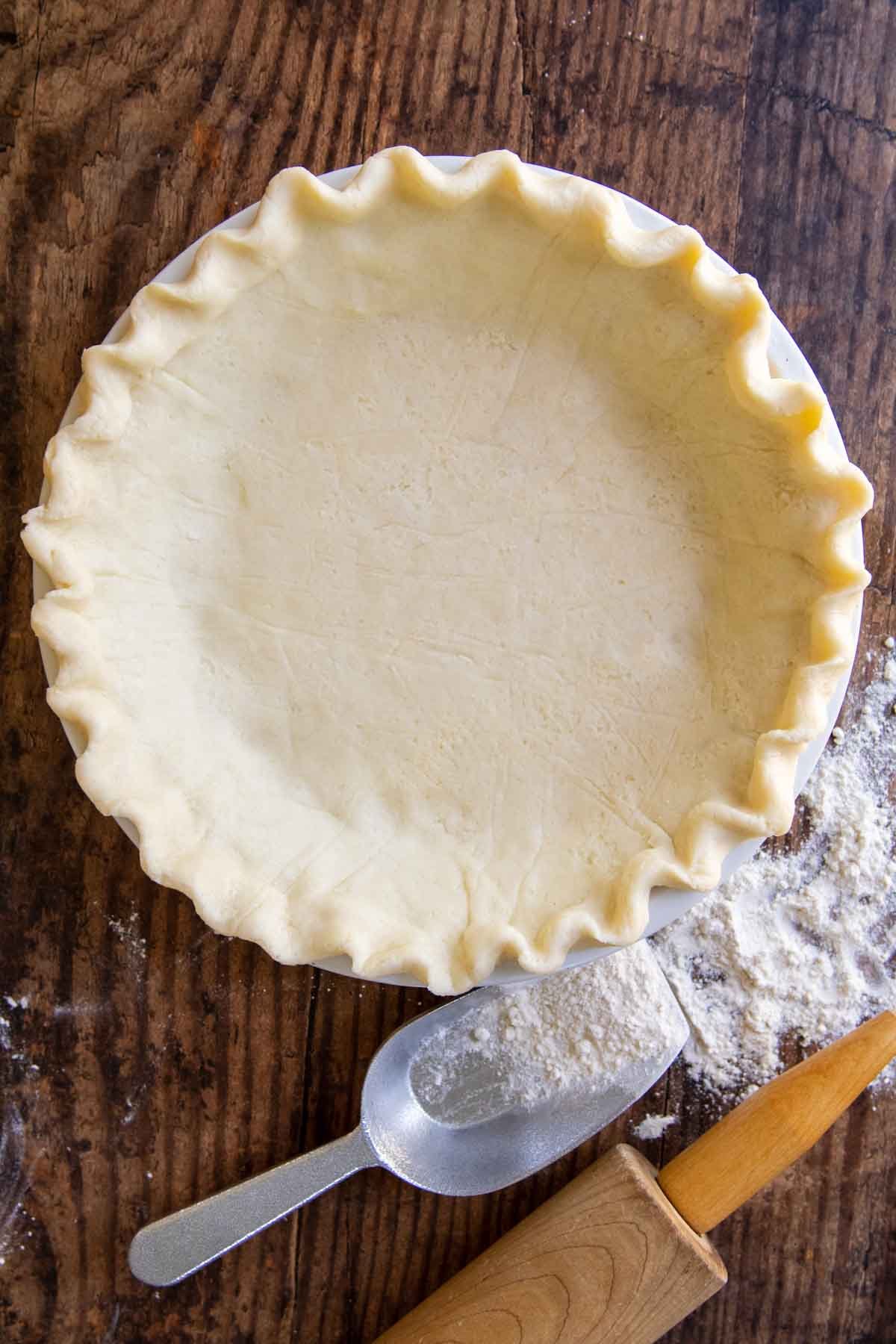
Easy Gluten-Free pie dough – flaky crust
I’ve always loved to bake, but the first time I tried making gluten-free pie dough I was in tears. What used to be so easy (pre-GF years), was now horribly frustrating with dismal results.
I had found other GF crust recipes to fill the void, such as oatmeal pie crust and almond flour pie crust, which don’t require rolling or chilling. But I was missing the perfect homemade gluten-free pie dough recipe to recreate the classics I grew up with.
Then a cookbook called America’s Test Kitchen: The How Can It Be Gluten Free Cookbook came along. Its revolutionary tips and tricks not only help me create the beginner’s guide to gluten-free baking, but inspired me to write a gluten-free cookbook of my own!
I learned making a gluten-free pie crust with sour cream was the essential ingredient I had been missing! It tenderizes the pastry dough by coating the starches, making a homemade GF pie crust that is light and flaky instead of dense and chewy.
Pie-making and I gladly reunited, and inspired me to create a whole collection of gluten-free pie recipes I thought I would never enjoy again!
Not only is this crust the best tasting, but I also include many tips, hacks, the best flour to use, recommended equipment, how to make the dough using a food processor or by hand, and rolling tips. I’ll teach you have to make the best gluten-free pie dough with consistent results every time!
Ingredient Notes
The recipe is for a single crust pies, but if need a double crust pie recipe, simply double the amounts. I do not included xanthan gum in the ingredients because most flour blends include it. If yours does not, add 1/2 teaspoon.
- All purpose gluten-free flour – I use and highly recommend for this recipe Cup4Cup gluten-free flour blend. However, I include more notes on different flours below.
- Sugar – A slight flavor boosts and helps make the crust more tender.
- Ice water – The colder the better!
- Sour Cream – Tenderizes the pastry dough by coating the starches. For a vegan or dairy-free recipe, I recommend substituting non-dairy greek yogurt.
- Vinegar – Makes a flaky texture. I prefer the taste of apple cider vinegar, but any will do.
- Unsalted Butter – Cubed and frozen for 10 minutes so it is very cold. Dairy-free, vegan butter sticks or shortening may also be substituted, but will affect the taste and flakiness.
Recommended equipment
Technically it doesn’t require much to make pastry crust. The basic requirements would be a bowl, fork, and rolling pin, so don’t the lack of “fancy” kitchen gadgets stand in your way!
However, if you have been frustrated with gluten-free pie crust recipes and are looking for consistent, easy results, some kitchen equipment can be a game changer! Below I explain why I recommend it for you to decide what is necessary, based on problems you run into.
- Food Processor – If you find making homemade dough to be intimidating, laborious, inconsistent, or complicated, using a food processor makes it extremely quick, easy and with foolproof results. From start to finish, it takes about 10 minutes and the blade does a much better job working the butter into the dry ingredients than a fork or pastry blender would.
- Silicone Dough Bag – If you struggle with rolling out dough, than this affordable tool is a must! I used to roll out between two sheets of parchment or plastic, but it would consistently crease and the dough would get stuck in the ridges. (See rolling tips for how to fix this!) But, this bag makes it easy to roll, size correctly, and transfer to the pie plate.
- Pie Shield – Covering the crust edges is essential when baking pies. Since the edges are exposed, they brown a lot faster than bottom crust or before the filling is baked through. The cheap fix is using aluminum foil, but I find it not to stay in place and hard to move the pie around to check on things.
- Metal Pie Pans – A common problem with GF pies is a soggy bottom crust. Fats have a harder time absorbing in GF starches, which often leads to a lack of flakiness or a soft bottom crust. Baking a gluten-free pie crust in a metal pan conducts the heat better and faster, which guarantees the best results!
- Pie Weight – If you need to blind bake a pie (bake the crust without a filling first) or partially bake a pie (helpful for fillings with a lot of moisture, like apple or pecan), something has to be placed in the crust to hold it down as it bakes. The cheap option is to place a piece of parchment on the bottom and fill with dried beans. However, I really like this pie weight because it doesn’t require parchment and it has holes so the heat can circulate to the bottom crust. Just put it on and bake.
How To Make Gluten-Free Pie Dough (Food Processor method)
(Below shows step-by-step photos and modified instructions. For the complete recipe, along with ingredient amounts, scroll down to the recipe card.)
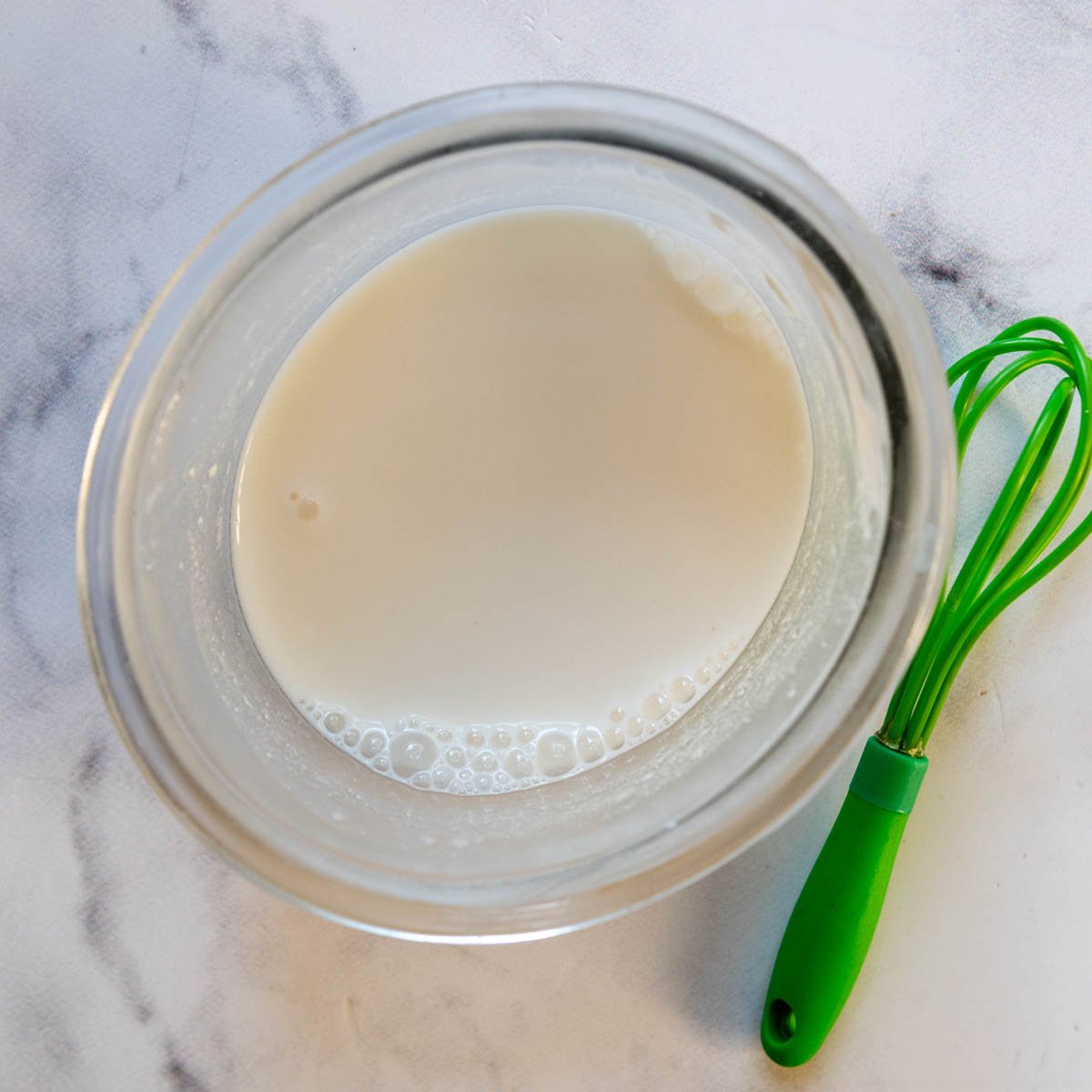
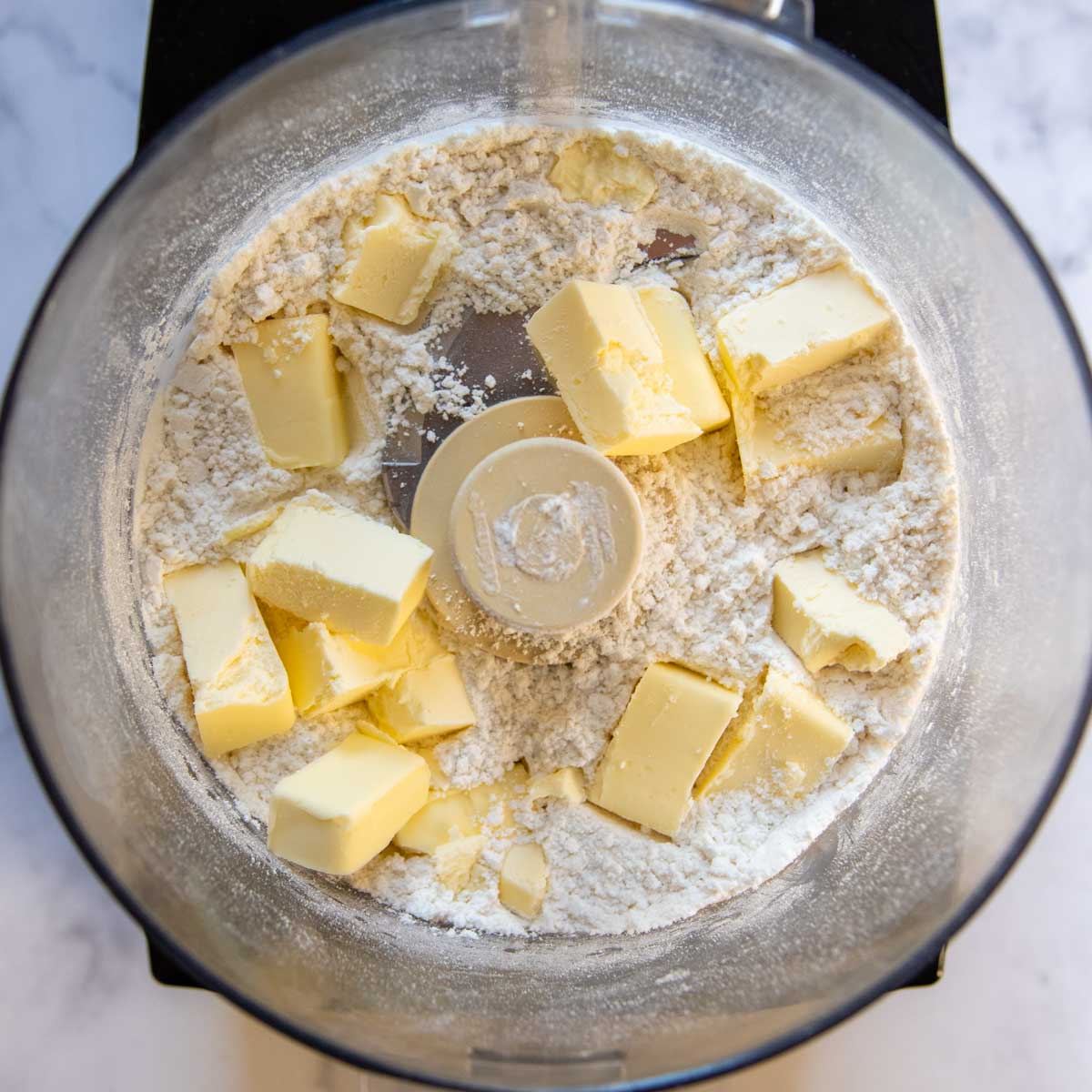
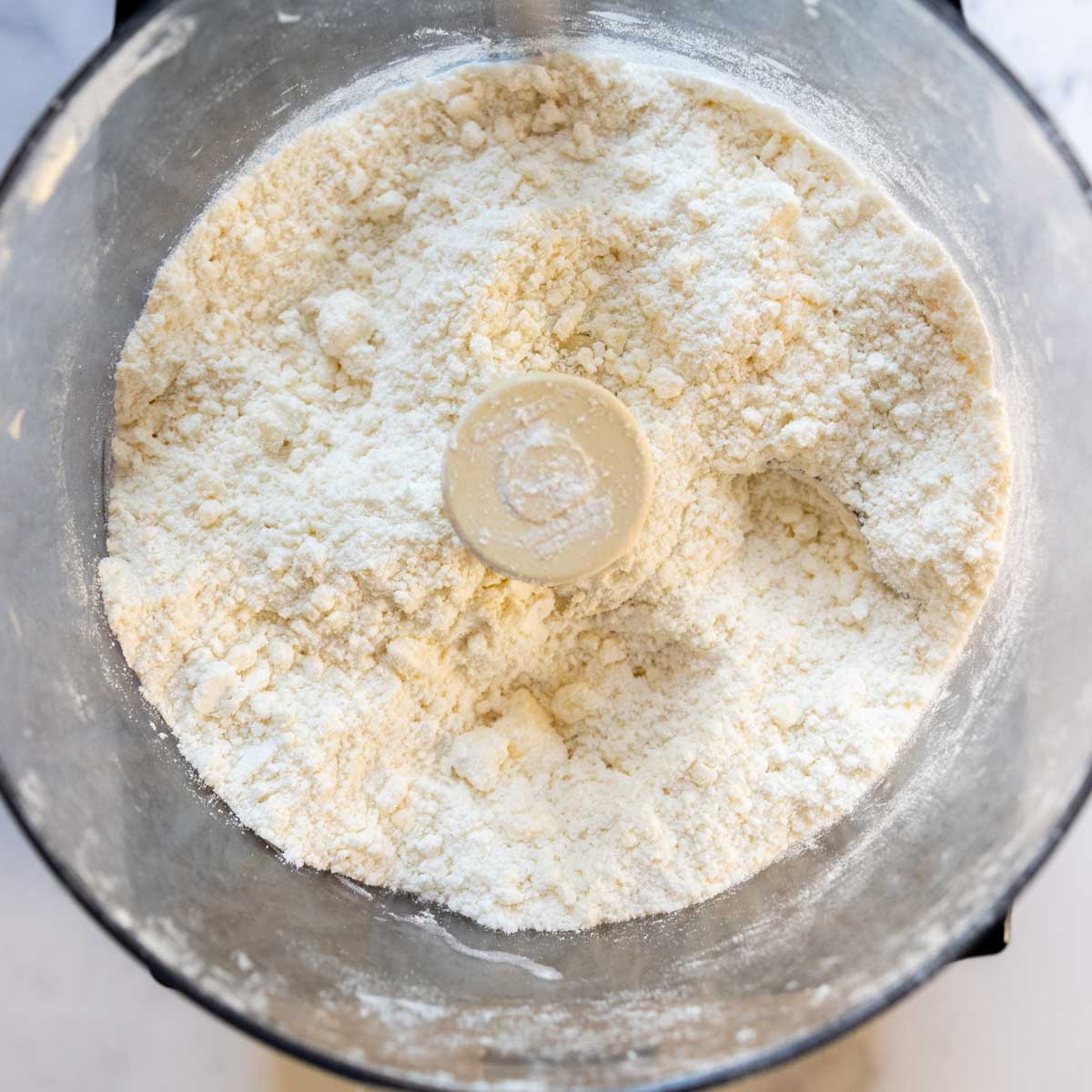
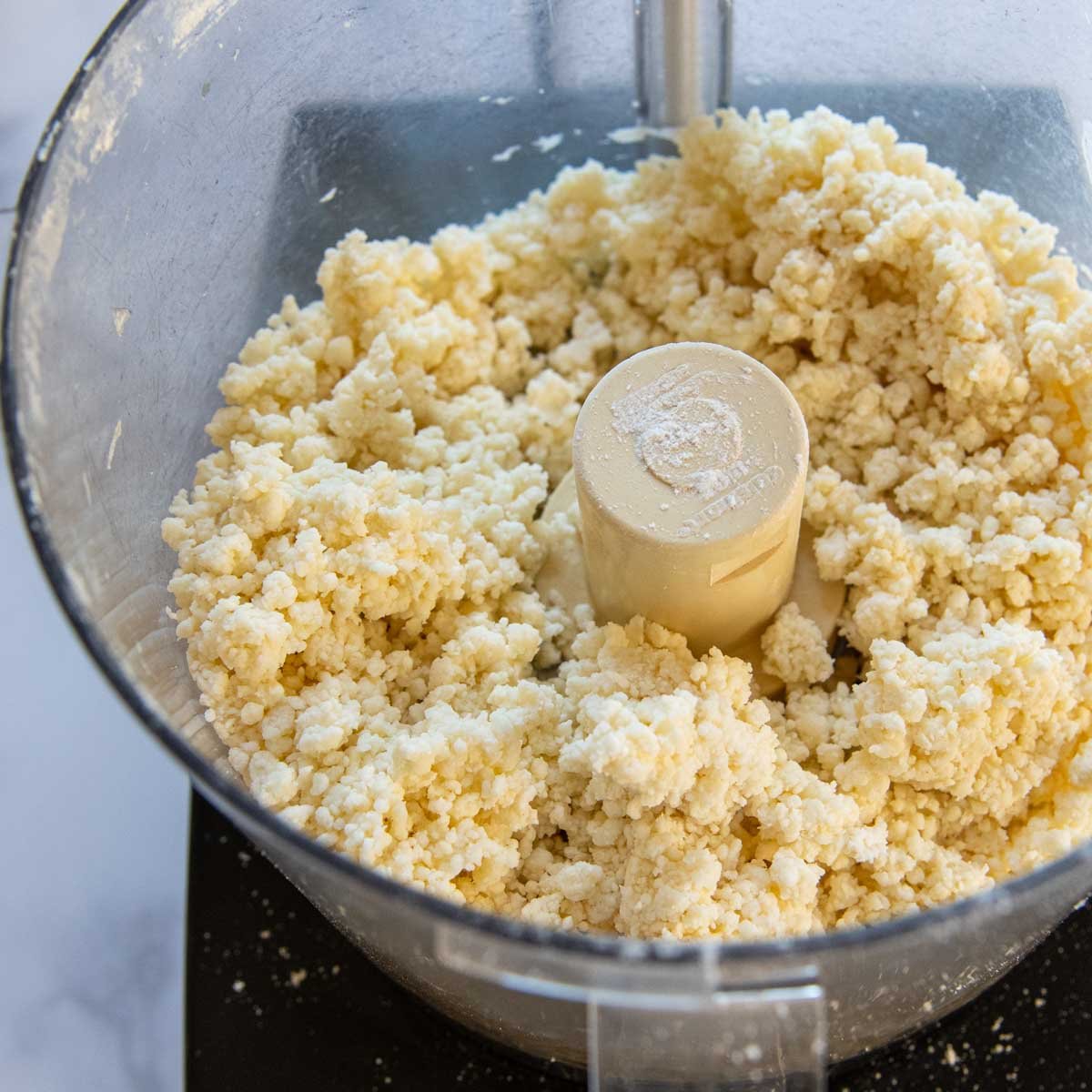
STEP 1 – PREP:
First, place the cubed butter in the freezer for 10 minutes. Mix together the cold water, sour cream, and vinegar in a small bowl. Place the liquids bowl in the refrigerator until you are ready to use.
STEP 2 – MIX:
Then, pulse together gluten-free flour, sugar and salt. Tip: Weighing flour with a food scale gives the most consistent results, especially with interchanging different gluten free flour brands. If you can’t weigh it, use a spoon to gently scoop it into measuring cup, then level off.
STEP 3 – BUTTER:
Add the cubed very cold butter. Process the butter into the flour mixture until well incorporated, evenly dispersed, and without large chunks.
STEP 4 – LIQUIDS:
Finally, add the liquids to the food processor and pulse until the flour becomes moistened and small dough clumps appear.
Tip: To check if you have enough liquid, clump and flatten a small bit of dough. If it doesn’t stick together, is crumbly, or breaks apart easily, add a small dash of ice water. Pulse a few times and recheck. If the dough is too wet or sticky, add a dash of flour. Pulse a few times and recheck.
STEP 4 – CHILL:
Now it’s time to chill the dough before rolling. Lay a large piece of plastic wrap on the counter and pour the gluten-free pie dough onto it. Shape into a disc, about 1 inch thick.
Wrap the plastic wrap tightly around the pastry dough and refrigerate for 1 hour or freeze for 30 minutes.
Tip: Wrapped pie crust dough may be refrigerate for 1-2 days. If storing longer, place the wrapped disc in a freezer ziplock bag and freeze up to 1 month. Thaw in refrigerator overnight.
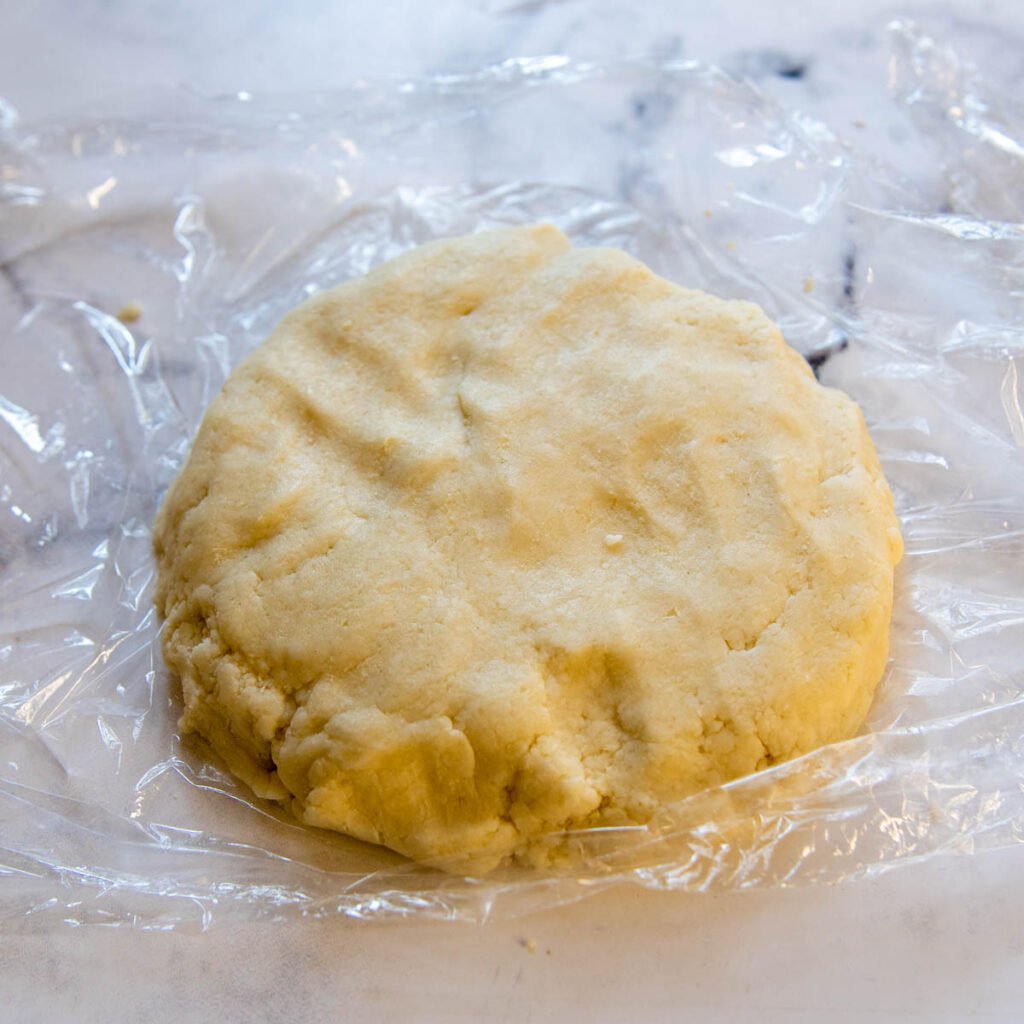
How to make gluten-free pie dough (By Hand Method)
- First, mix together the cold water, sour cream, and vinegar in a small bowl. Freeze the butter for 10 minutes until very cold.
- In a large bowl whisk together the gluten-free flour, sugar and salt.
- Use a pastry blender, fork, or fingers to cut and knead butter into the dough until it is well incorporated throughout.
- Add half the liquids and knead with fingers or a fork. Pour in the remaining liquids. Knead until the dough starts to come together and the liquids are well mixed with flour.
Tips for Rolling gluten-free Pie Crust
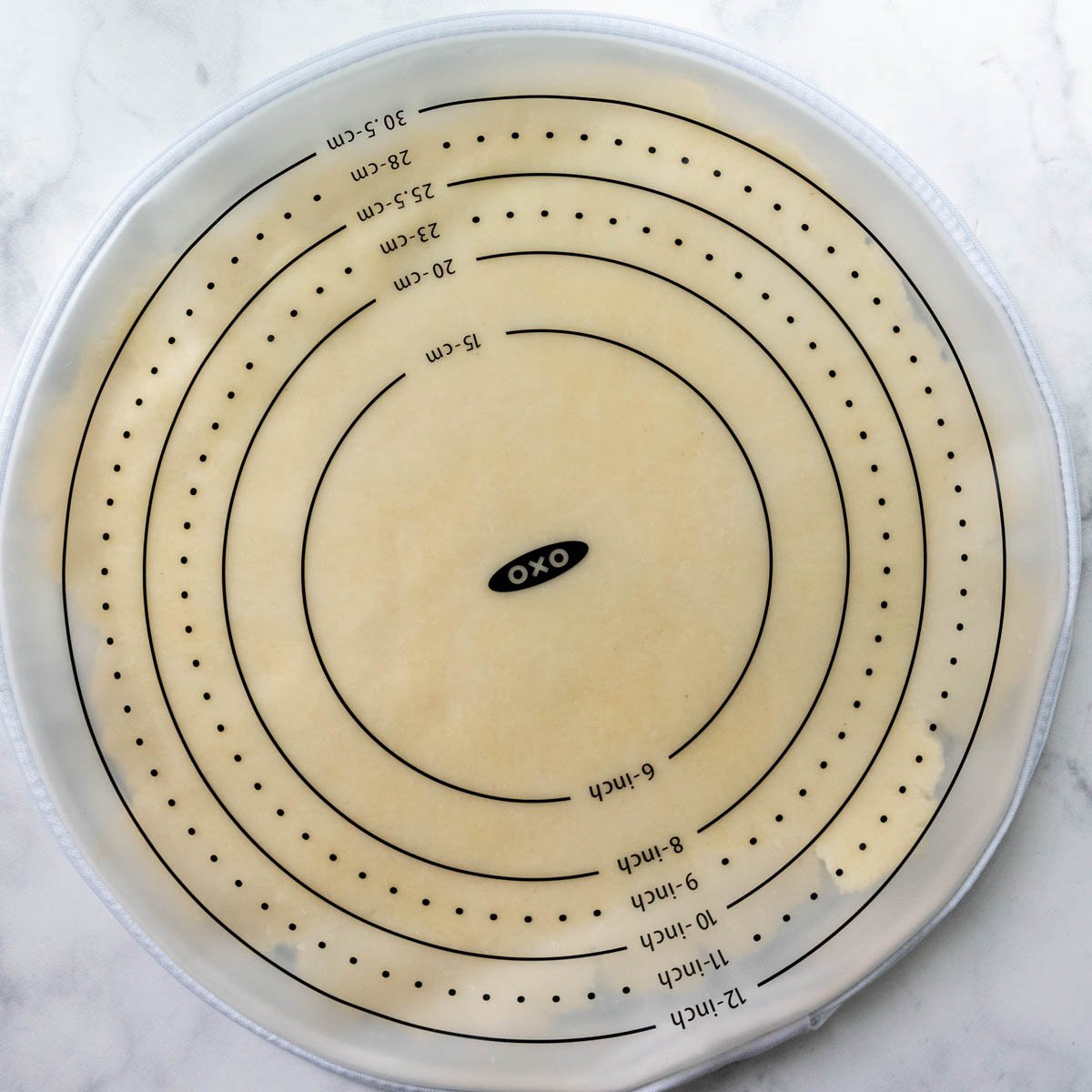
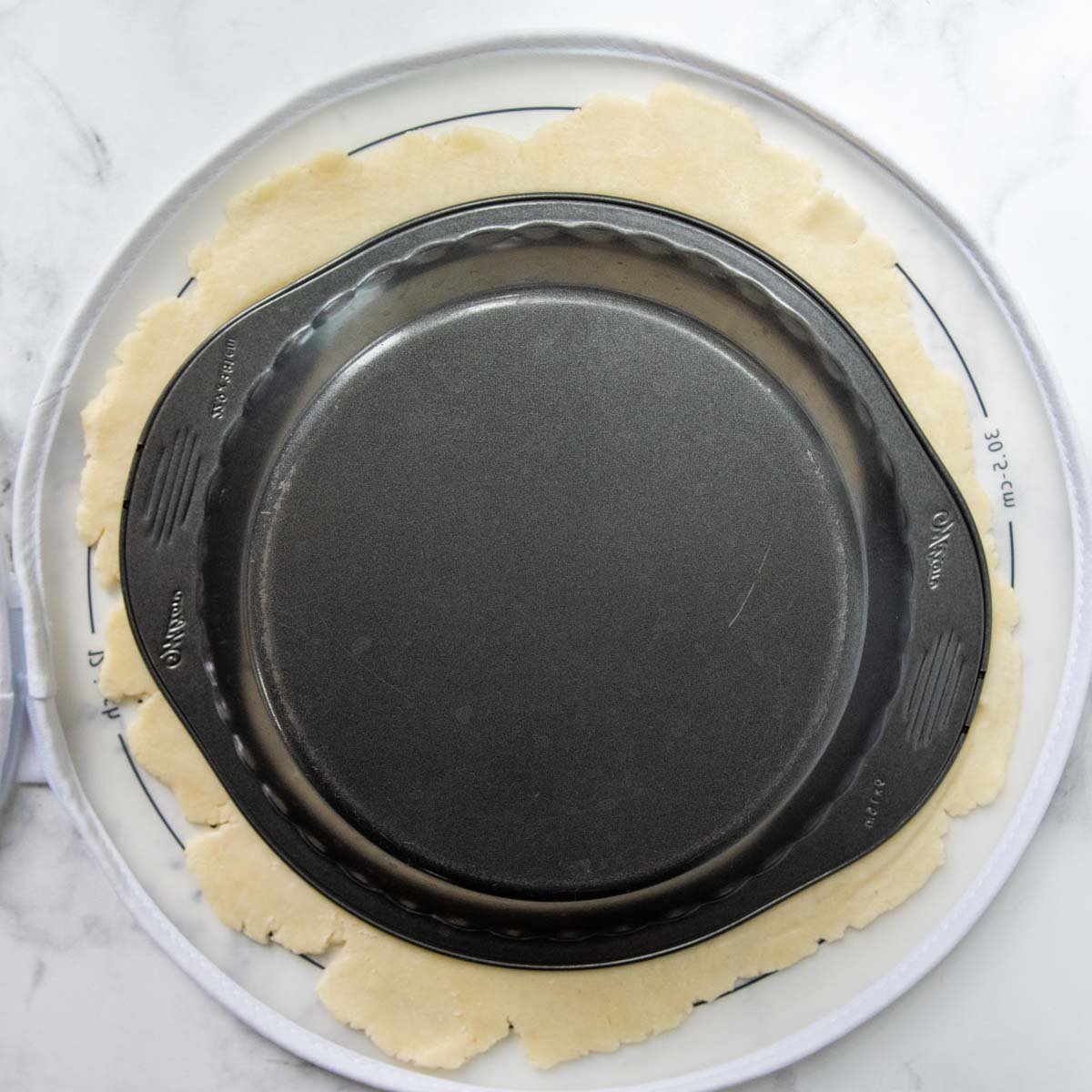
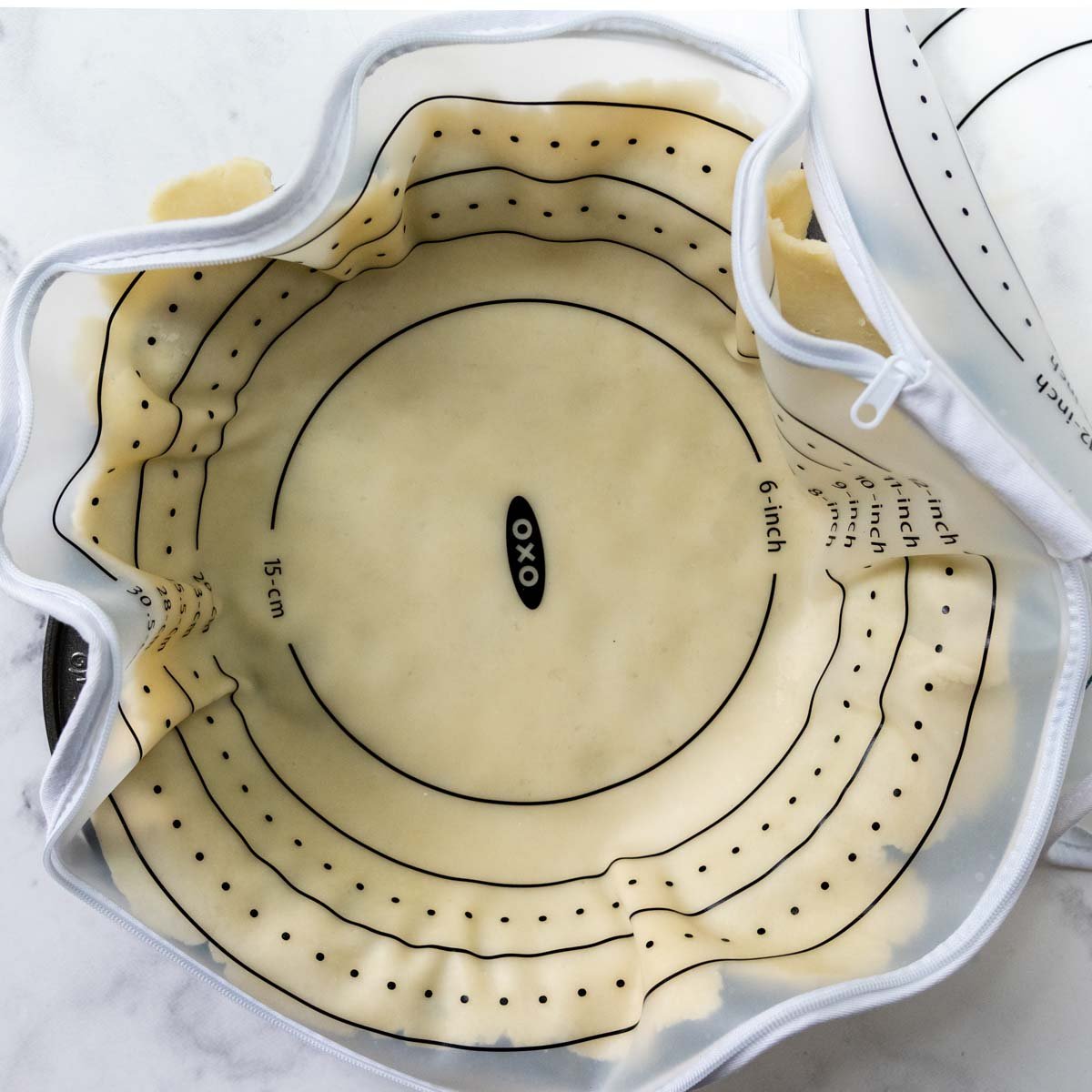
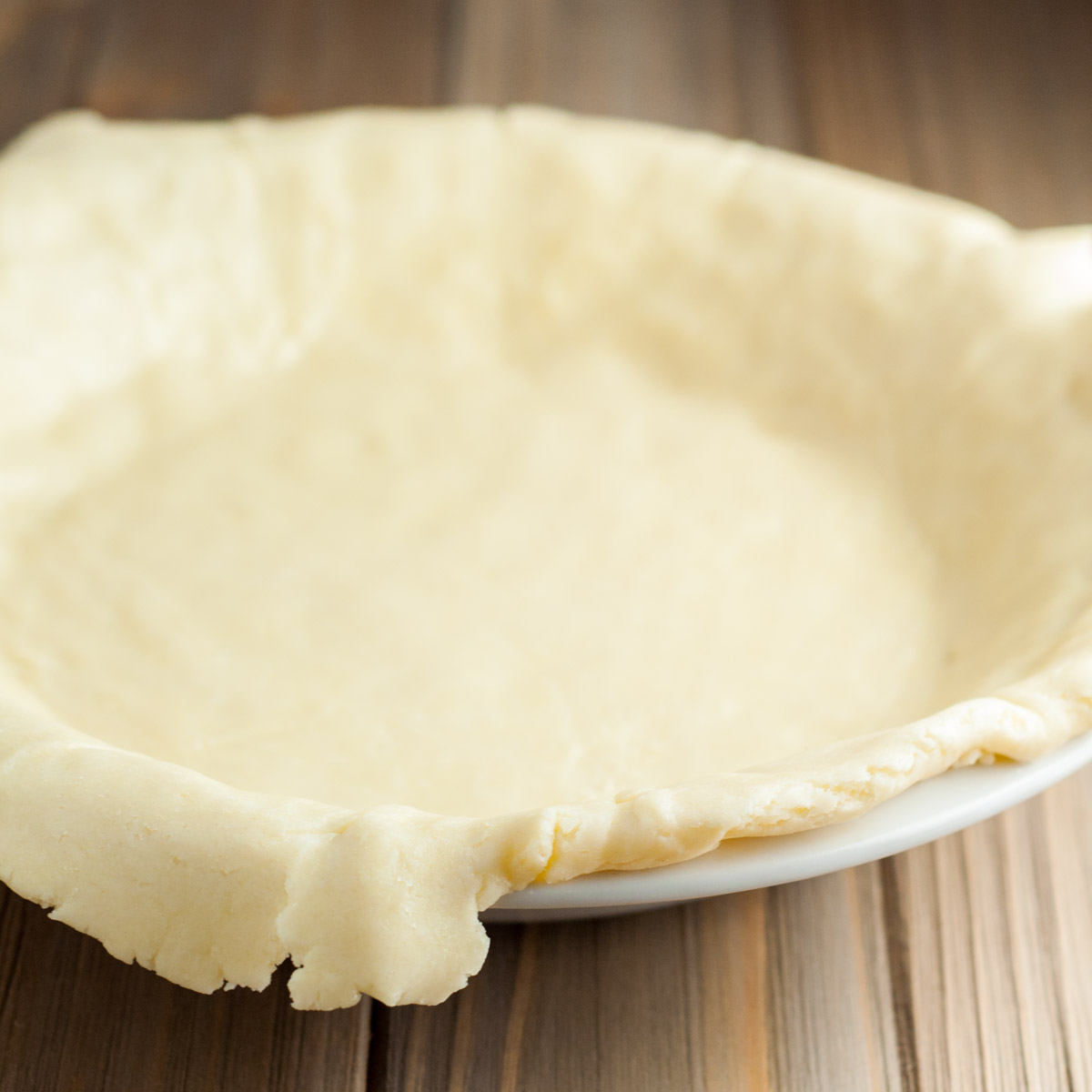
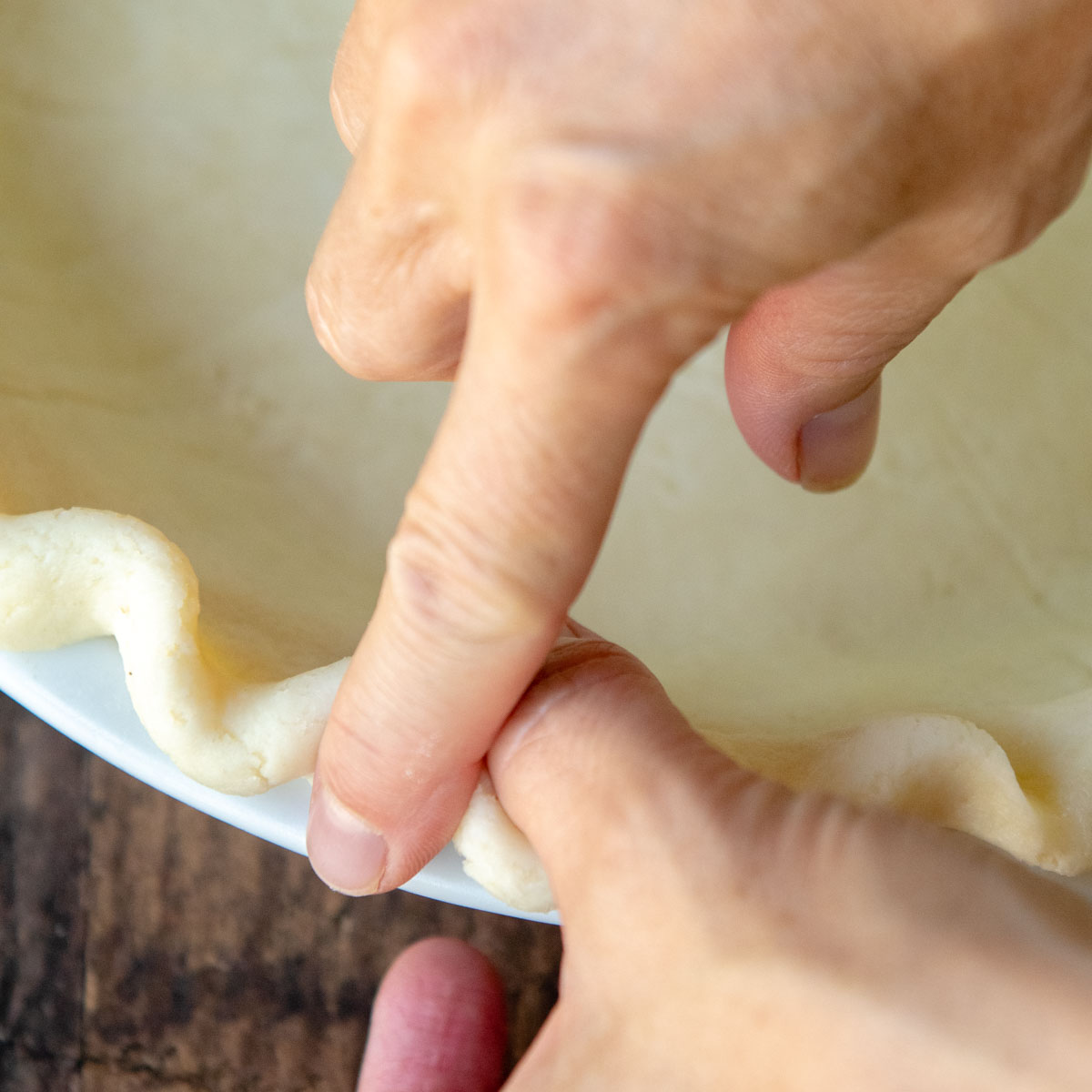
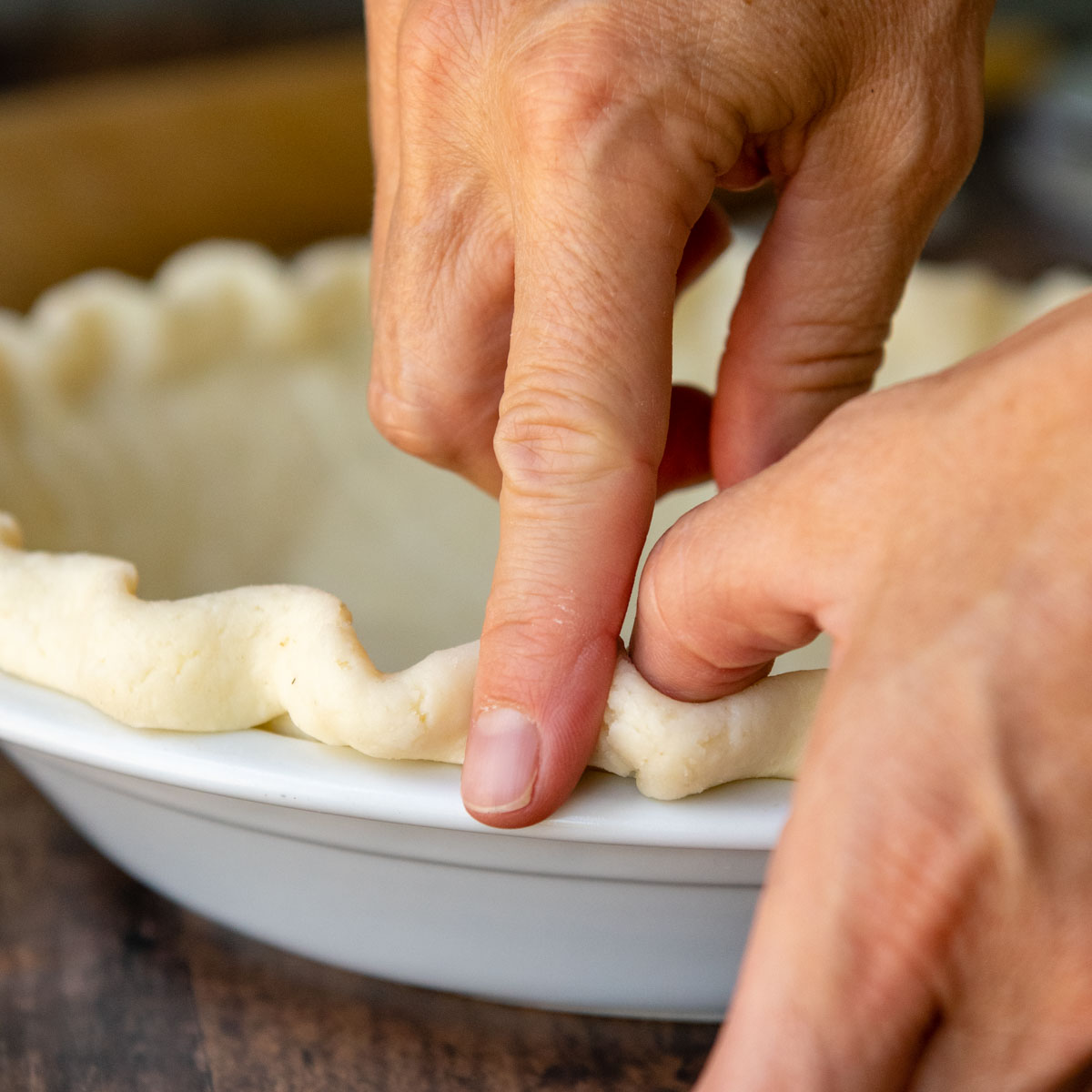
- I find rolling in a silicone pie bag works best because the dough doesn’t stick, no additional flour is needed, and it’s easy to shape. If you don’t have one, use two large pieces of parchment paper. Plastic wrap may be used, but it has a tendency to stick to the dough more.
- If the dough is too cold it will be hard to roll and break apart. Let it sit on the counter for 5 minutes and try again.
- When you are rolling, press down in the middle and push the dough out from center. This will ensure the middle not being too thick, while edges are too thin.
- Rotate the pie dough as you are rolling so it forms a perfect circle. If one side is bigger than the other, cut some dough off and add it to the smaller side of the circle.
- While rolling, the dough may warm, which causes the parchment paper to stick. If this happens, place rolled pie crust, with parchment still on, in the refrigerator for 5 minutes so butter re-solidifies and releases from the paper.
- Once the dough is turned over in the pie dish use kitchen scissors to trim off excess dough around edges. If some edges need more dough to fold under, press on some of the clipped-off pie dough.
- Use two fingers to flute into a decorative. For a shiny crust brush the exposed edges with an egg wash before adding filling.
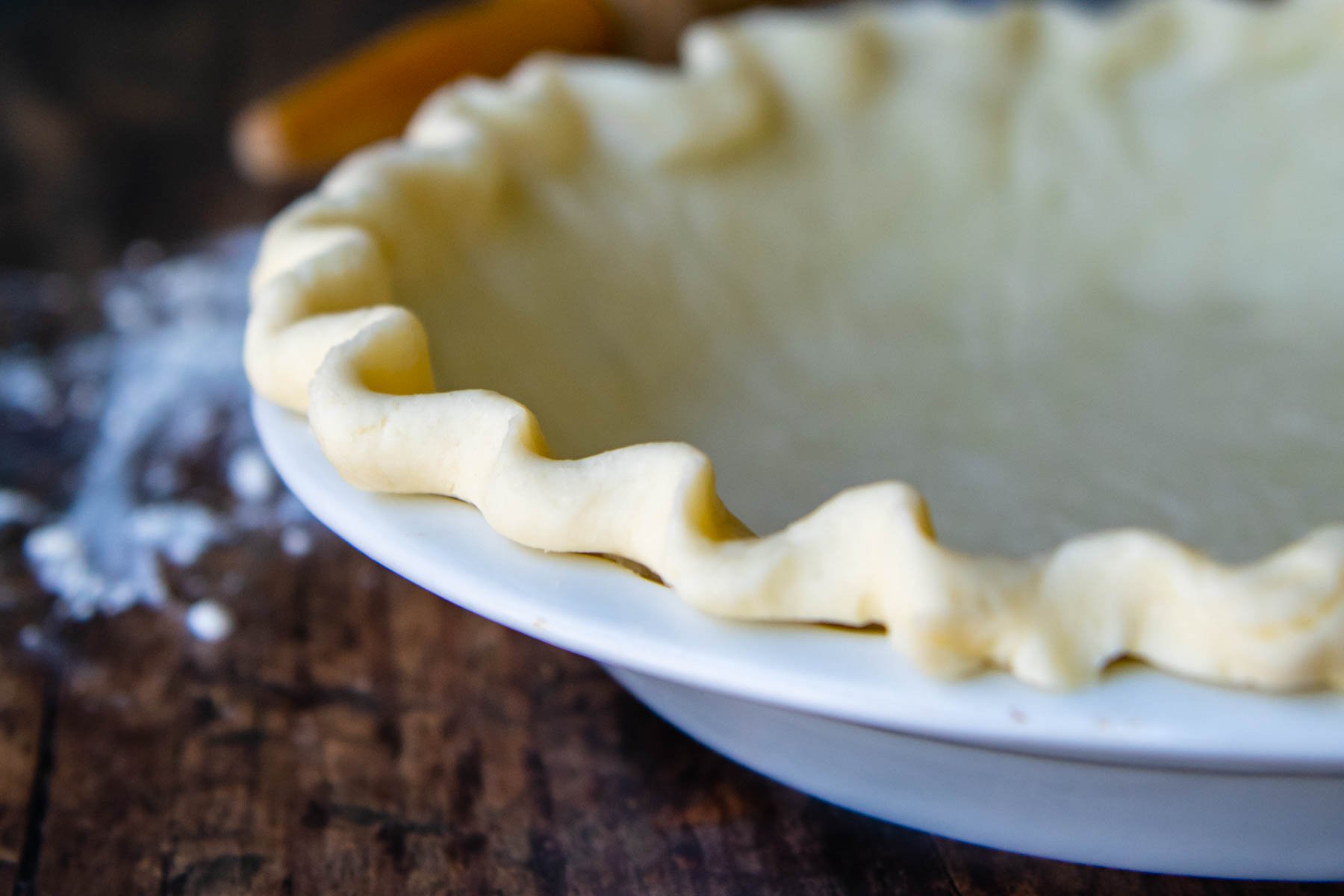
Methods for baking
Once the dough is rolled out and shaped in your pie pan, move the dish to the freezer for 15 minutes or up to 1 hour. When the dough is chilled and firm, add the pie filling and bake according to the recipe.
Double Crust or Lattice Crust
This recipe yields enough for single crust pies. If your recipe calls for a double crust or lattice top, double the ingredients and divide pastry dough in two discs to refrigerate.
Here is a great tutorial on how to make a lattice top with this easy gluten-free apple pie recipe. For a double crust, invert the top crust over the filling and trim edges, if necessary. Seal the top and bottom edges together, tucking under, and then use your finger and thumb to make a decorative edge.
Partially-Baked Pie Crust
For recipes that call for a partially baked bottom of the crust, before filling, preheat the oven to 375ºF. Place a pie weight on the bottom of a chilled crust. Alternatively, line the bottom with a piece of parchment paper and top with dried beans.
Bake on the middle rack for 20-25 minutes, rotating halfway through.
Fully Baked or blind baked Pie Crust
Some recipes require a fully baked pie shell, such as cream pies. Follow directions for partially-baked pie crust, adding 5-10 minutes to cooking time, and removing the liner with the beans for last 10-15 minutes. Bake until the bottom crust is golden brown.
Tip: I highly recommend using this silicone adjustable pie shield when baking pies. It will keep the crust golden brown instead of burnt before the filling is ready.
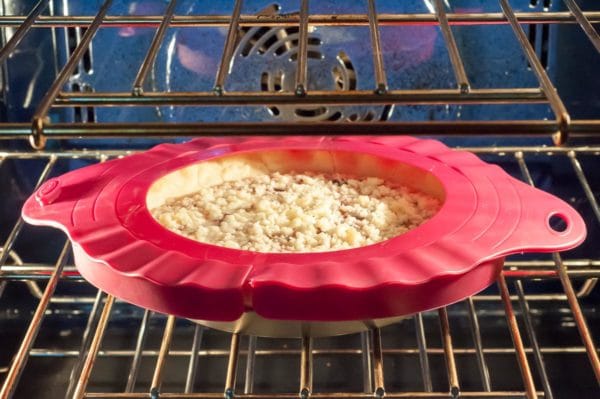
Dairy-free modification or using shortening
If you prefer using shortening in pie crusts you may replace the butter with an equal amount.
If you are wondering if shortening is gluten-free, it does not contain any ingredients that have wheat or gluten. Crisco does state their products are made in a shared environment, so those with particularly sensitive allergies should be careful.
For a gluten-free dairy-free or vegan pie dough plant-based butter sticks or shortening may be substituted, but will affect the taste and flakiness. I also recommend cutting the salt by half if using plant-based butter. Replace the sour cream with a dairy-free substitute.
Make-ahead tips
Gluten-free pie dough with sour cream can be prepared up to 24 hours ahead of time and refrigerated until ready to use. If you require the crust further in advance, you have a couple options.
Either wrap the dough disc securely in plastic wrap and then transfer to a ziplock freezer bag. Freeze up to 2 months and thaw overnight in the refrigerator before rolling out.
The dough may also be rolled out and placed in a pie pan. Wrap the unbaked crust securely with plastic wrap and freeze up to 1 month. When ready to bake, fill the frozen crust and bake as directed.
Note About Gluten-Free Flours
I’ve tried this recipe with three different store-bought gluten-free flour blends. Below are my pie crust making and tasting notes using three popular flours, but go to this article for a complete guide on the best gluten-free flour.
- Recommended: Cup 4 Cup Gluten Free Flour – I’m a huge fan of this flour for gf pie crusts and all baking. It rolls out well and yields a flaky, tender texture. Plus, the taste is so much like regular flour, no one suspects it’s gluten free.
- Bob’s Red Mill Gluten-Free 1 to 1 Baking Flour – This flour was very easy to work with and rolled out well. However, the texture was a bit more chewy, not as flaky, and slightly more dense than Cup4Cup. The flavor had an off-putting aftertaste.
- King Arthur Measure-for-Measure Gluten-Free Flour – I had the hardest time with this one. The dough was dry so I had to add more liquid to get it to bind together. The baked texture was chewy and dense, probably from the starch to liquid ratio being off.
gluten-free pie fillings
Now that you have a dependable gluten free pie dough recipe, there are plenty of options for fillings. Below are some of my favorite pies to make!
- Gluten Free Chicken Pot Pie
- Southern Gluten-Free Sweet Potato Pie
- Gluten-Free Pumpkin Pie Filling
- Gluten-Free Pecan Pie
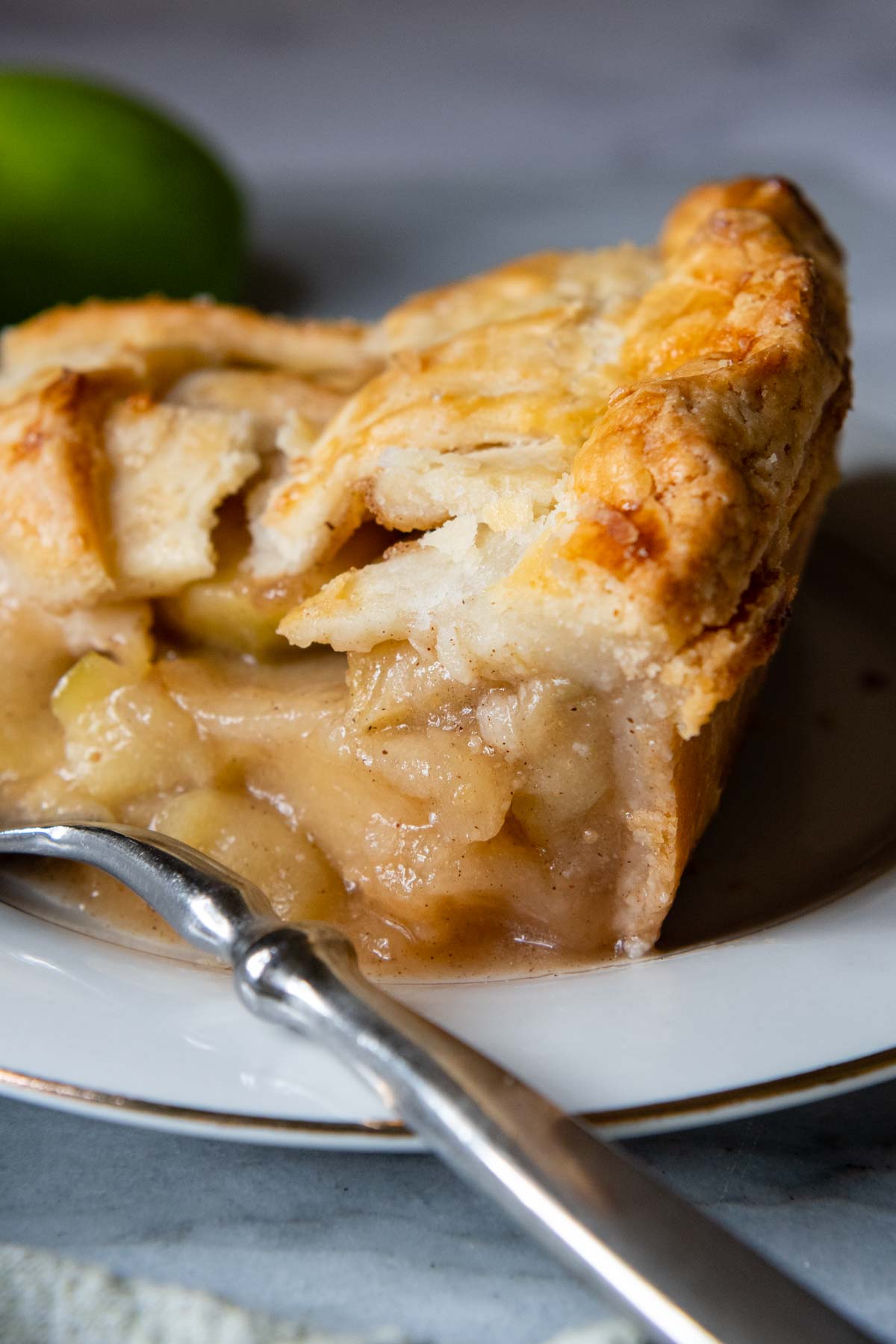
SAVE THIS recipe for GLUTEN FREE PIE dough TO YOUR PINTEREST BOARD!
Let’s be friends on Pinterest! I’m always sharing great recipes!
How to Make Gluten-Free Pie Dough (Best Results)
Listen to Recipe Audio
Equipment Needed
Ingredients
- 8 tablespoon (113 g) unsalted butter cut into small cubes and frozen for 10 minutes
- 2 ½ tablespoons ice water
- 1 ½ tablespoons sour cream
- 1 ½ teaspoon apple cider vinegar
- ¾ PLUS ⅔ cup (194 g) gluten-free flour I highly recommend Cup4Cup gluten-free flour
- 1 ½ teaspoon granulated sugar
- ½ teaspoon salt
Instructions
Food Processor Method:
- Place the cubed butter in the freezer for 10 minutes. Mix together the cold water, sour cream, and vinegar in a small bowl. Place the liquids bowl in the refrigerator until you are ready to use.8 tablespoon (113 g) unsalted butter,2 ½ tablespoons ice water,1 ½ tablespoons sour cream,1 ½ teaspoon apple cider vinegar
- Pulse together the flour, sugar, and salt together until mixed.¾ PLUS ⅔ cup (194 g) gluten-free flour,1 ½ teaspoon granulated sugar,½ teaspoon salt
- Process the butter into the flour mixture until well incorporated, evenly dispersed, and without large chunks.
- Add the liquids to the food processor and pulse until the flour becomes moistened and small dough clumps appear. Tip: To check if you have enough liquid, clump and flatten a small bit of dough. If it doesn’t stick together, is crumbly, or breaks apart easily, add a small dash of ice water. Pulse a few times and recheck. If the dough is too wet or sticky, add a dash of flour. Pulse a few times and recheck.
- Turn the dough onto a large sheet of plastic wrap and flatten into a thick 1" disk. Wrap tightly and refrigerate for at least 1 hour or freeze for 30 minutes. Before rolling out, let sit on counter 5 minutes so it is easier to work with.
By Hand Method:
- Mix together the cold water, sour cream, and vinegar in a small bowl and place in the fridge until ready to use. Freeze the butter for 10 minutes until very cold.
- In a large bowl whisk together the gluten-free flour, sugar and salt.
- Use a pastry blender, fork, or fingers to cut and knead butter into the dough until it is well incorporated throughout.
- Add half the liquids and knead with fingers or a fork. Pour in the remaining liquids. Knead until the dough starts to come together and the liquids are well mixed with flour.
- Turn the dough onto a large sheet of plastic wrap and flatten into a thick 1" disk. Wrap tightly and refrigerate for at least 1 hour or freeze for 30 minutes. Before rolling out, let sit on counter 5 minutes so it is easier to work with.
How To Roll Out Crust:
- I find rolling in a silicone pie bag works best because the dough doesn’t stick, no additional flour is needed, and it’s easy to shape. If you don’t have one, use two large pieces of parchment paper. Plastic wrap may be used, but it has a tendency to stick to the dough more.
- Place the unwrapped dough disc in middle. Use a rolling pin to press and spread the dough from the middle out. Roll into a circle slightly larger than your pie dish. (See tips in recipe notes for rolling out crust)
- Remove the top paper, and invert into the pie plate. Remove the second paper. Tip: If the dough has warmed while rolling, it may be trickier to take the paper off. If this happens, leave the paper on, and stick the whole thing in the fridge for 5 minutes. Once the crust is chilled again it's much easier to pull off the paper. If the dough is too cold and the crust breaks, let it sit on the counter for a minute first before trying again.
- Trim off excess dough around the edges. If some edges need more dough to fold under, press on some of the clipped off pie dough. Tuck the overhang dough under to meet edge of pie dish. Using both forefingers, flute edges by pressing one down and one up next to each other.
- Wrap loosely with plastic wrap and place in freezer 15 minutes, or up to an hour, until chilled. Fill and bake according to recipe directions, or see recipe notes for a partially or fully baked crust.
- DID YOU MAKE THIS RECIPE?? DON'T FORGET TO LEAVE FEEDBACK AND/OR CLICK A STAR RATING ON THE RECIPE CARD
Recipe Notes
Double Crust or Lattice Crust
This recipe yields enough for single crust pies. If your recipe calls for a double crust or lattice top, double the ingredients and divide pastry dough in two discs to refrigerate. Here is a great tutorial on how to make a lattice top with this easy gluten-free apple pie recipe. For a double crust, invert the top crust over the filling and trim edges, if necessary. Seal the top and bottom edges together, tucking under, and then use your finger and thumb to make a decorative edge.Best tips For Rolling Out Crust
- If the dough is too cold it will be hard to roll and break apart. Let it sit on the counter for 5 minutes and try again.
- When you are rolling, press down in the middle and push the dough out from center. This will ensure the middle not being too thick, while edges are too thin.
- Rotate the pie dough as you are rolling so it forms a perfect circle. If one side is bigger than the other, cut some dough off and add it to the smaller side of the circle.
- While rolling, the dough may warm, which causes the parchment paper to stick. If this happens, place rolled pie crust, with parchment still on, in the refrigerator for 5 minutes so butter re-solidifies and releases from the paper.
- Once the dough is turned over in the pie dish use kitchen scissors to trim off excess dough around edges. If some edges need more dough to fold under, press on some of the clipped-off pie dough.
- Use two fingers to flute into a decorative. For a shiny crust brush the exposed edges with an egg wash before adding filling.
Baking Methods
Partially-Baked Crust: For recipes that call for a partially baked bottom of the crust, before filling, preheat the oven to 375ºF. Place a pie weight on the bottom of a chilled crust. Alternatively, line the bottom with a piece of parchment paper and top with dried beans. Bake on the middle rack for 20-25 minutes, rotating halfway through. Fully Baked (Blind Baked) Crust Some recipes require a fully baked pie shell, such as cream pies. Follow directions for partially-baked pie crust, adding 5-10 minutes to cooking time, and removing the liner with the beans for last 10-15 minutes. Bake until the bottom crust is golden brown. Tip: I highly recommend using this silicone adjustable pie shield when baking pies. It will keep the crust golden brown instead of burnt before the filling is ready.Storing / Freezing
Wrapped dough may be refrigerated up to 1 day. Longer than that, place the wrapped disc in a freezer ziplock bag to freeze for 1 month. Thaw in refrigerator overnight. Recipe adapted from America’s Test Kitchen: The How Can It Be Gluten Free Cookbook.Nutrition
This post contains affiliate links. My opinions are always my own. If you purchase a product through an affiliate link, I make a small commission – at no cost to you. Read full disclosure policy here.

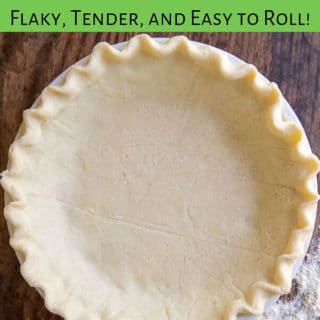
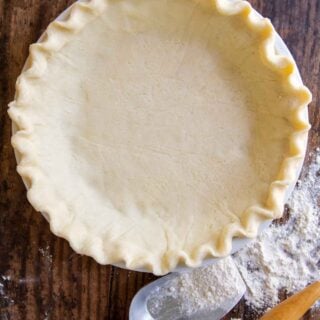
Sandy says
This looks like a wonderful flaky pie crust but please clarify the 3/4 cup PLUS 2/3 cup flour. It says 194 gr total weight. Is the 2/3 cup
in ADDITION to the 3/4. A bit confusing as written. I was reading your pot pie recipe and came over to the crust recipe to get straightened out in my head. Btw, I love your other recipes. TIA
Melissa Erdelac says
Hi Sandy,
Yes, you are right. It’s 3/4 cup and then add 2/3 cup too, which together equals 194g, if you’d rather measure by weight. Let me know if you have any questions!
Best,
Melissa
Anonymous says
Hello
Thx for the quick response. Yes better to ask than be sorry. The 194 gr was helpful in understanding. I do weigh my flour if called for in a recipe. Your tortillas are awesome. I’ve tried many!!!!!! And yours are my go to now. Thanks again.
Marie says
Your recipe for gf pastry is no fail and so easy … I cannot thank you, enough, for sharing ! I don’t even refrigerate it after making BUT I do freeze the pastry for 15 minutes before I bake it ! I made lemon tarts and used cupcake liners then put in my weights … perfection ! Thanks again for making my life so much easier with less tears … Marie
Melissa Erdelac says
Love this, Marie! Ironically, making GF pie crust for the first time is what reduced me to tears. I used to LOVE making homemade crust. I was so happy when I finally found a recipe that I could do with success again!
Best,
Melissa
Debi says
I used Extra White Gold brand of gluten free AP flour found at Walmart. Crust was easy to wirk with and I like the way it didn’t shrink and pull away from the edges. Wish I could post a pic of it because it was beautiful!
Melissa Erdelac says
Love this, Debi! So glad to hear it worked with that brand of GF flour as well because unfortunately they all work differently!
Best,
Melissa
Marie Gilchrist says
Finally, I found a gluten free pie dough that works and when I mean works … it’s perfect ! I made 1 double batch of dough, one I left in the fridge, overnight, and one I used as directed. I found the disc I left in the fridge overnight was even better … no tears and no tears !!!! Thank you sooooooooo much !
Marie
Melissa Erdelac says
So grateful for this, Marie! Thank you for taking the time to let me know!
Best,
Melissa
Linden E Jenesse says
Hi, Melissa!
I’m a new sub. I have recently started my GF journey, and I have to eliminate a “few” other things as well! I was wondering two things:
Primarily, can I substitute an organic palm oil shortening for the dairy, or is there a better suggestion for a dairy-free recipe?
Also, have you tried the Namaste brand of GF flour? I get it from Costco. Just wondering your thoughts.
I just bought a can of pumpkin to experiment sans gluten, sugar and dairy… I’m happy to have found this recipe! Thanks!
Melissa says
Hi Linden,
Yes, you may substitute palm oil shortening for the dairy, but a better option might be using Earth Balance Vegan Butter Sticks, if you can have those. I would omit the salt from the recipe, though.
As far as the flour, I have used Namaste and unfortunately I wouldn’t recommend it because of the taste and texture. I find it very gritty and there are better flours out there. If you go to my gluten-free flour post, you can find an alternative without dairy.
Let me know if you have any other questions!
Best,
Melissa
Val says
This is the best tasting GF pastry I have made, however i could not cut it and put it on a plate without it crumbling. Can you advise ?
Melissa says
Hi Val,
I’m glad you enjoyed the taste! The crumbling could be a tad too little liquid was added. You may have to adjust a little less or more, depending on the flour you are using. Once you mix the liquids together, add just enough until the dough just starts to come together. If you squeezed some in your hand it would bind, but it may still look sandy on it’s own. Different flours will absorb moisture different, as well as conditions of the day will affect it, such as humidity. Was it crumbly when your rolled it out or just after baking? Also, what brand flour did you use?
Best,
Melissa
Val says
I used Bobs Red Mill GF 1 to 1 flour. It didn’t appear crumbly when rolling, in fact I think it rolled really well. It was only once I tried to slice it to put on the plate to serve. (BTW I used it as a top for a veg pie no crust bottom)
Val says
I used Bobs Red Mill GF 1 to 1 baking flour. It rolled out really well, I didn’t think it was crumbly. The problem was only once I tried to slice it to serve it just crumbed. (BTW it was the top cover for a crustless veg pie)
Melissa says
Hi Val,
Would you be open to trying a different flour next time? I find Bob’s to be very forgiving when using to roll out for crusts, cookies, or pizzas, but after cooking it doesn’t have the best texture. Since it’s pretty forgiving, it could have been a little shortage of liquid or just the flour. I wrote a post comparing the most popular GF flours, if you want to take a look at others that work well for pie crust.
Best,
Melissa
Val says
Hi Melissa
I am in Australia and Bob’s was the only one I could find here. Thanks for all your help. I have ordered your book and look forward to its arrival. 😎
Kind Regards
Julie G says
This is The Best GF pie crust recipe!! My non-gf son in law raved about the crust & was shocked when I told him it was gf! I feel I have arrived in the baking world when I can make a beautiful pie! This. Is. It!! Thank you for a grand recipe!
Melissa says
Wow, Julie! I’m so glad this recipe made you a baking superstar! Thank you so much for taking the time to share!
Best,
Melissa
Sandra Amos says
Hi – I have read the reviews and will try this recipe very soon. I live in the UK and of course our flour blends vary to yours’ but Dove’s is a popular one here and I use it often so will make with this. Just wondering if Greek style yogurt will be as good do you think as I always have this in the fridge’ and it is full fat?
Many thanks
Sandra
Melissa says
Hi Sandra,
Greek style yogurt would be fine. I used it before as well.
I do have UK bakers reach out about the GF flour because Cup 4 Cup isn’t available there. However, I’ve tested this recipe with various other US brands and it seems to work well with all of them. Would you mind dropping me a line after trying it with Dove’s? I’d love to add that info to the post if it works out well!
Best,
Melissa
Sandra Amos says
Hi Melissa – thanks for your very quick reply. I am making this today (bought the sour cream yesterday as I want to replicate yours’). I will try the Greek yogurt another time and of course I will get back to you with the results which I am sure will be great.
Many thanks
Sandra
Sandra Amos says
Hi Melissa
I don’t think my reply went yesterday so trying again (apologies if you have it elsewhere). The pastry was, as you mention could be a possibility, very sticky and I did struggle to get it off the parchment, but succeeded. I decided to lightly dredge the base with oat flour, before then lining with parchment and baking beans as I was sure the parchment would stick again when removing after par baking, and this worked like a dream. When rolling the pie top I decided to do so between layers of cling film and this worked better, although I did dredge the film again with oat flour which would work the same I am sure with parchment.
The baked pie was very good, both my husband and son really enjoyed it too.
Just one very quick question. Would the pastry be affected if omitting the sugar as I wonder if this adds to the overall stickiness? I am sure it is there for a reason though that I am unaware of🤔
Thanks for the recipe and I know I will be back.
Sandra
Melissa says
Hi Sandra,
Thanks for following up. The sugar isn’t necessary, it just enhances the flavor. Different GF flours absorb moisture differently, so next time you may just have to add an additional 5-10 grams to offset this before rolling out. Adding the oat flour works, too, though! Glad everything worked out and thanks for letting me know!
Best,
Melissa
Robin Shearer says
In the Notes Section it’s mentioned that using a scale is the best way to measure ingredients and I agree. However the recipe uses American standard measures. Do you have a metric recipe?
Thanks,
Robin
Melissa says
Hi Robin,
Thanks for writing. Under the ingredients you can click between US and Metric amounts and it will automatically calculate it for you. So it would be 184g flour and 114g butter. Enjoy!
Best,
Melissa
Bethany says
Thank you for this recipe! I’ve been gluten free for many years and have tried many pie crusts. This one is like the unicorn/ holy grail of gluten free. I’ve only used this recipe for the last two years.
This week, I gave it a try with the Pillsbury Best Multi-Purpose Gluten Free Flour Blend. In the past, I’ve used the Bob’s Red Mill 1 to 1. I loved the results with the Pillsbury. It was a beautiful flaky crisp crust.
Melissa says
Hi Bethany,
Well you have made my Thanksgiving! I’m very appreciative of you taking the time to let me know! It’s always good to learn how other GF flours turn out. Thanks for sharing. 🙂
Best,
Melissa